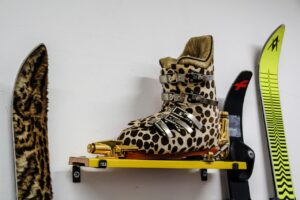Ski boots can be one of the most uncomfortable pieces of equipment in your arsenal, but they’re also one of the most important.
If you don’t get a good fit on your ski boots and bindings, you’re likely to have issues with knee pain or other injuries when you hit the slopes.
But if you’re like me and have a hard time knowing when your boots need adjusting, it can be hard to know what’s going wrong (or right) with them.
That’s why I’ve put together this list of five common causes for discomfort in ski boots: wrong size, bad fit, wrong flex, bad buckle habits, socks and what to do about each one!
5 Common Causes Your Ski Boots Might Be Hurting
Ski boots are designed to be comfortable, but sometimes they can cause pain and discomfort. If your ski boots are causing pain, there are a number of reasons why this could be happening. Here are five common causes:
Wrong Size
The most common cause of boot pain is a size mismatch. When you’re trying on ski boots, they should be a bit snug but not so tight that your toes are squished or you can’t wiggle them.
If the boot fits properly, there should be about a finger’s width between the end of your toe and the end of the boot (if it feels too tight in this area, try putting some insoles inside).
If you have trouble fitting any part of your foot into a ski boot, chances are good that it’s too big for you and vice versa!
Bad Fit
If your boots don’t fit properly, they can cause pain and discomfort. A bad fit can be caused by a variety of factors including:
- Too tight
- Too loose
- Too wide (your feet are too far apart) or narrow (your feet are too close together).
Wrong Flex
- The boot should flex with the ankle. If your boot is too stiff in this area, it can cause pain in the Achilles tendon and calf muscles.
- The heel of your ski boots should be stiff enough to provide support but not so much that it limits how far back you can bend your knees when skiing downhill this is called “flexing at the waist.”
- In addition to being stiffer than other parts of the sole, skiers with wide feet may need extra stiffness in their toe box area because wide feet tend to absorb more shock than narrow ones do; thus they require more support from their boots’ soles.
Bad Buckle Habits
The buckles on your ski boots are designed to be used with only one type of shoe, and it’s important that you don’t mix them up. When you buckle your boots up for the first time, use one buckle for each foot (and then make sure they stay that way).
If you’re going skiing regularly, consider investing in a pair of ski boot buckles that work with all sports and shoes this way, if you decide to go snowboarding instead of skiing one day or vice versa, it won’t matter which set of buckles you use.
The tension on these types of straps should feel snug but not too tight.
Socks
You’re probably wearing the wrong socks.
Wearing the right pair of ski socks can go a long way toward preventing blisters, foot pain, and general discomfort. Here are some tips for choosing the right ones:
- Wear socks that are comfortable and breathable–not cotton! Wool is best because it’s naturally insulating but won’t make your feet sweat too much (and therefore get cold). It also absorbs moisture more effectively than synthetic materials do, which keeps bacteria from building up in your boots over time.*
- Socks should fit snugly but not too tight; if they’re loose enough to slide around inside the boot shell when you put them on or take them off then they’re too big!
Conclusion
We hope this article helped you understand why your ski boots might be hurting. If you are still struggling with pain or discomfort, we recommend seeking out a professional who can help you find the right fit.
